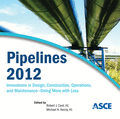Who Says You Need Multiple Wire Breaks for a PCCP Pipe to Fail?
Publication: Pipelines 2012: Innovations in Design, Construction, Operations, and Maintenance, Doing More with Less
Abstract
On Sunday, October 5, at about 2:30 a.m. a section of 72-inch prestressed concrete cylinder pipe (PCCP) failed. The 72-inch-diameter PCCP was nominally capable of sustaining an internal pressure of 281 psi. Previous examinations of the pipeline, utilizing the best available nondestructive examination techniques, provided little indication that this pipe section was at risk of failure. Examination of the failure indicated that about 2 feet of the north (bell) end of the failed pipe section was gone. Local scouring that had occurred around the adjacent blowoff did not apparently compromise that structure. In addition, the carbon fiber lining of the adjacent pipe section was damaged during the failure. The probable failure sequence commenced with breakage of one or more wires adjacent to other, previously failed wires, near the bottom of the pipe. As the wires broke, the coating and core sheared, ripping the cylinder. The force of water directed downward and to the east lifting the end of the pipe enough to allow the gasket to push out of the spigot on the adjacent pipe, from approximately the 11:00 o'clock to 1:00 o'clock positions. As the thin cylinder tore, it twisted, along with the rotation of the end of the pipe. As the water pushed its way out of the pipeline, the radial force of the water continued to tear the remaining cylinder away, resulting in significant radial cracking. Further damage was halted by the shutdown of the aqueduct within one hour after the break occurred. The sudden and catastrophic failure of this section of pipe is the result of a combination of factors. Poor manufacturing, bedding and backfill, and an improperly placed joint diaper resulted in the exposure of the highly stressed wires to high, fluctuating groundwater in a corrosive environment. The corrosion and eventual breakage of enough wires led to reducing the strength of the pipe enough to allow the internal pressure to exceed the strength of the concrete core and steel cylinder resulting in the failure of the pipe section. The Water Authority has utilized state of the art technology to monitor their pipelines in real time which records the location and quantity of PCCP wire breaks. Unfortunately, current technology doesn't locate broken wires near the joints. Because of this, there was no indication that that this pipeline would fail. Until such time as a method is discovered that can not only detect broken wires adjacent to joints but detect corrosion of the cylinder, it is recommended that any wire break detected by any method near a pipe joint be treated with concern.
Get full access to this article
View all available purchase options and get full access to this chapter.
Information & Authors
Information
Published In
Copyright
© 2012 American Society of Civil Engineers.
History
Published online: Nov 9, 2012
ASCE Technical Topics:
Authors
Metrics & Citations
Metrics
Citations
Download citation
If you have the appropriate software installed, you can download article citation data to the citation manager of your choice. Simply select your manager software from the list below and click Download.
